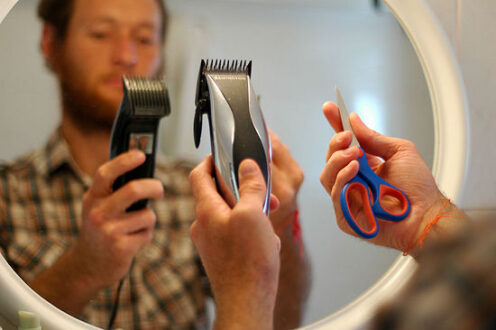Trichotemnomania (TTM) is described as a mental disorder that is characterized by compulsive habit of hair cutting or shaving hair which ultimately results in the alopecia or hair loss.
It is a condition in which patients try to cut or shave their hair especially in the area of the head and around the eyes which provides them with some sort of briefed feeling of positivity or pleasure. They try so hard to cut or shave their hair that it may result in severe distress and heavy hair loss. Any kind of forceful resistance to this habit may typically fail and leads to a more distressful condition.
Majorly it is considered as a genetic disorder that runs in the family. But sometimes other disorders such as OCD (obsessive-compulsive disorder) or body dysmorphic disorder can lead to this condition. Among these patients the vulnerability to the adoption of this habit of hair cut or shave is most likely to happen in episodes following the periods of anxiety or stress. These patients are usually well-aware of their habit and they admit their behavior meanwhile, on examination of the head area provides evidence of this habit in the form of their hair-cutting or shaving in this particular area. In some cases, patients may tend to shave off their hair to improve the way they look because their existing look may give doubts or negative feelings about them.
This disorder is more likely to occur among the female population and the prevalence is about 10% greater than in men. It is estimated to develop in every one to four percent of the population and more likely to affect them in their childhood or early adult age.
In 1889, this disorder was firstly named by François Henri Hallopeau.
Trichotemnomania Definition
“Trichotemnomania is derived from a Greek word “temnein” meaning “to cut” and “mania” meaning “madness” it is characterized by the habit of knowingly cutting or shaving the hair by the patients resulting in the ultimate hair-loss.”
It is very similar to trichotillomania but can be differentiated based on self-knowledge of this habit of self-induced alopecia among the patients.
Trichotemnomania Symptoms
Trichotemnomania may pose many signs and symptoms which sometimes become very difficult to evaluate. The most common signs and symptoms may involve;
- Shaved or hair-cutting in different in a irregularly manner.
- As the hair does not come out easily so the person tries to cut or shave their hair may result in the damaged and de-shaped hair ends with negative results.
- Scaling in the scalp area is mainly absent in most of the patients and they exhibit a normal density of hair growth.
- As the patients are well-aware of this habit which may lead to the lower self-esteem commonly associated with the negative behavior of the people around them.
- The environment plays an important role in this condition as many patients in a comfortable environment may forget about this habit.
- Isolated behavior among these patients is really common.
Other clinical impediments may involve;
- Infections
- Permanent alopecia
- Repetitive stress injuries
- Carpel tunnel syndrome
- Gastrointestinal obstruction: Some patients may eat their cut or shaved off under extremely stressed conditions and may result in the adoption of trichobezoar characterized by a hairball in the gut. Its complex condition is called Rapunzel syndrome.
Trichotemnomania Causes
Several underlying reasons are explained by the researchers which may involve;
- Genetics: It is commonly called as a genetic disorder which involves the mutations in the SLITRK1 gene.
- MRI studies of the trichotemnomania patients have posed an increased volume of gray matter in comparison to the normal population.
- A decreased volume of the cerebellum has been observed in certain MRI studies of trichotemnomania patients.
- Abnormalities in the caudate nucleus may lead to the development of this disorder.
- Anxiety and depression are considered as potential triggers for the development of this disorder.
- Obsessive-compulsive disorder (OCD).
- Patients having post-traumatic stress are later on more likely to develop this disorder.
Trichotemnomania Treatment
Treatment of trichotemnomania (TTM) depends upon the age of patients as the complexity of this disease tends to enhance with the increase in age leading to more critical management.
However, there are many ways established by the professionals to manage this order which may involve;
Psychotherapy: It involves cognitive behavioral therapy (CBT) that involves the behavioral modifications by proper counseling methods. It is also called a habit reversal training of the patients.
Medication therapy: No drugs have been approved yet by FDA to treat this order but meanwhile, Fluoxetine and other selective serotonin reuptake inhibitors (SSRIs) have shown some clinical significance in this matter but it has also been observed that these drugs may tend to increase the habit of hair cut or shave in some patients.
Device therapy: Certain mobile applications have been developed to help in the habit reversal training and CBT.
 Health & Care Information
Health & Care Information 


